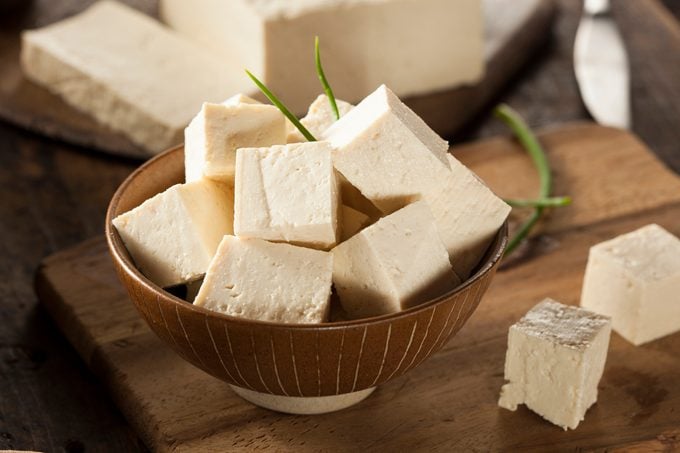What to Know About Tofu’s Nutrition, Calories, and Protein
Updated: Jun. 29, 2021
Find out more about tofu's benefits and nutrition, including its protein, calories, and carbs. (Plus how to cook tofu, and recipes to try).
Our editors and experts handpick every product we feature. We may earn a commission from your purchases.
The rise (and rise again) of tofu
If tofu is new to you, know that it has a decades-long history in the United States and an even longer history worldwide. Not only is the soy product versatile but it also packs a health punch. Tofu nutrition is no joke.
Also known as bean curd, tofu has been around for thousands of years. The earliest records of its consumption date back more than 2,000 years to China, and it became a staple in Chinese cuisine in the 10th century.
Other Asian countries adopted it over the following centuries, but tofu did not appear in many U.S. grocery stores until the 1970s.
Since then, it has become a major protein source for countless people who follow vegetarian, vegan, or plant-based diets. It’s popular enough that you’ll find it in most grocery stores and restaurants.
Here’s what you should know about tofu nutrition, including its calories, carbs, and protein, as well as how to use it.
What is tofu?
Tofu is basically soybean curd, made by curdling soy milk, explains Jackie Newgent, RDN, a plant-focused chef, nutritionist, and author of The Clean & Simple Diabetes Cookbook.
The first step to making tofu is to make soy milk.
Dried soybeans are washed, soaked, and ground up. Water is added to the mix, then the solution simmers for 15 to 30 minutes. It’s drained through a piece of cloth in a sieve.
The soy milk that remains contains all of the soybeans’ beneficial nutrients.
The next step is coagulation, which involves heating the milk at a low temperature along with a coagulant, most commonly nigari, a sea water extract.
The final step involves pressing the coagulated soy milk into white edible blocks, Newgent says, which is how tofu is often packaged at the grocery store.
“In a packaged tofu, a standard ingredient list may include water, soybeans, nigari, and calcium sulfate,” she says.

What are the types of tofu?
There are different types of tofu, varying in consistency and firmness.
The softer the tofu, the higher the water content. This makes it more likely to fall apart but also means it is more taste absorbent.
As firmness increases, so do density, durability, fat, and protein content.
The most common forms of tofu, according to Newgent, are silken, soft, medium firm, extra firm, and super firm.
Silken tofu
This form of tofu has the highest water content and is actually undrained and unpressed.
“Silken is ideal for smoothies,” Newgent says. It also works well in sauces, dips, desserts, and salad dressings.
Soft tofu
Soft tofu is one step firmer than silken, with a higher water content than the firmer varieties. It is generally used similarly to silken.
Medium tofu
With a little less water content than soft, medium tofu is still delicate enough that it would fall apart in a frying pan. This is the type of tofu found floating in miso soup.
Firm tofu
Firm tofu is dense enough for cooking and is a popular choice for everything from simmered curries to tofu scrambles.
Some people like to use it in stir fries, but it may fall apart more than some of the firmer options.
Extra-firm tofu
Newgent maintains that extra-firm is great in stir fries because it holds its shape well if you slice it.
You can also use it when making grilled and baked tofu.
Super-firm tofu
Super firm is the densest tofu, and very high in protein.
Other types of tofu
Other types of tofu are becoming increasingly popular.
Precooked tofu is already flavored and baked, and can be found in the refrigerated section of grocery stores.
Also be on the lookout for black tofu, which is made from yellow and black soybeans, Newgent says.
And due to the growing popularity of plant-based foods, there are new faux tofus popping up in natural markets “as an alternative to traditional soybean-based tofu,” she explains.
Pumfu, for instance, is made with pumpkin seeds.
Tofu nutrition
Because tofu is plant based, it is cholesterol free and has minimal saturated fat, explains Ellen Liskov, a registered dietitian nutritionist at Yale New Haven Hospital.
“The firmer the tofu, the higher the protein content and overall calories because there is less moisture,” she points out.
While the exact nutritional value varies with type of tofu as well as brand, the average three-ounce portion (a generous half cup) of firm tofu contains the following nutrients.
Calories
A three-ounce serving of firm tofu has about 80 calories.
Saturated fat
A serving also contains less than half a gram of saturated fat.
That’s “about 3 percent daily value, or 3 percent of our day’s needs, based upon a 2,000-calorie-a-day diet, which is average for Americans,” Liskov explains. “For nutrients we want to limit, like saturated fat, less than 5 percent daily value is good. So this is considered low in saturated fat.”
Protein
There are eight grams of protein in a three-ounce serving of tofu, which is 15 percent of our daily need.
Sodium
The sodium content is “very low” at five milligrams, or less than 1 percent of the daily value.
“Again, this is important because the typical American eats too much sodium,” Liskov says.
Of course, if you buy pre-flavored tofu, pay attention to the nutrition label to make sure a lot of salt wasn’t added.
Carbohydrates
Tofu is also low in carbohydrates, with two grams per serving. That accounts for 1 percent of your daily needs. Most of the carbohydrate content is from fiber.
Fiber
Fiber varies from between one and three grams, depending on the brand.
“Foods with at least three grams of fiber are a good source of dietary fiber,” Liskov points out.
Calcium
Tofu is a good source of calcium, Liskov says. It offers 10 percent of the daily recommended value for calcium, based on the average need for 1,300 milligrams of calcium per day.
“Foods with 10 percent daily value or more for a nutrient is considered a good source of that nutrient,” she says.
If you don’t consume animal products (and therefore avoid cow’s milk), you may be able to get more calcium by eating tofu.
Iron
Tofu is also a great source of iron, offering 6 percent of the daily value, based on the average need of 18 milligrams a day.
Tofu benefits
There are many benefits of adding tofu to your diet.
It is a high-protein plant food
For anyone on a meat-free diet, tofu is a great alternative.
“Tofu is rich in plant protein and is an excellent swap for meat, nutritionally speaking,” Newgent says.
Liskov agrees. “This is a good substitute for meat, poultry, even fish,” she says.
It is good for the environment
Tofu is good not only for your body but also for the natural environments on which we all depend.
That’s because it’s a less carbon-intensive protein source than meat. So eating tofu contributes less to climate change.
“As a plant protein food, tofu is a much more environmentally friendly source of protein than meats like beef and lamb, which significantly contribute to greenhouse gas emissions,” Newgent explains.
It could help lower cholesterol
Newgent points to research that says tofu’s soy isoflavones (helpful antioxidants) may help reduce LDL cholesterol levels.
“That’s the ‘bad’ cholesterol,” she says. When LDL cholesterol gets too high, it can raise your risk for heart problems.
It can help improve heart health
Tofu may have cardiovascular benefits.
“Numerous studies cite the benefits of eating a plant-forward diet related to risk reduction for heart disease and also diabetes,” Liskov says.
It may reduce your risk of breast cancer
There is some research to suggest soy can effectively keep breast cancer at bay.
One highly cited 2020 study, published in Cancer Research, found that women who consumed soy products at least once weekly reduced their risk of developing breast cancer by 48 to 56 percent, likely due to the isoflavones in them.
It may help with menopause symptoms
Newgent explains that soybean foods, including tofu, contain phytoestrogens, which may play a role in curbing hot flashes and other symptoms of menopause.
A analysis of 19 studies, published in Menopause, found that supplements with soy isoflavone effectively reduced the severity of menopause-induced hot flashes by more than 26 percent.
Is there any risk of eating tofu?
While there is some confusion about the health effects of soy, the general consensus is that most people can safely consume it without any issues.
Some research has linked eating high amounts of soy to breast cancer, but this theory is not widely accepted. And recent studies, like one published in 2020 in PLOS One, have found the opposite.
In fact, studies have found that in geographical regions where soy is a primary source of food, breast cancer rates are lower.
Of course, if you’re allergic to soy, you’ll want to avoid tofu.

How cook tofu
Tofu is far more adaptable than many people realize. “You can bake, scramble, panfry, air fry, simmer, sauté, stir-fry, grill, and blend it,” Newgent says.
Another great thing about tofu? It’s super versatile.
“It is somewhat chameleon-like, so it’ll take on the flavors of what you add to it,” she says. “So don’t be shy with seasonings.”
Before cooking, spend some time pressing the excess water from the tofu. You can do this by putting the tofu between layers of paper towels, and putting a small weight—like a can of beans—on top. The paper towels will absorb the excess liquid in about 30 minutes.
“This will help it to brown upon cooking,” Newgent says.
Alternatively, if you use tofu often, you’ll likely want to get a tofu press. The device makes pressing tofu a cinch, and does it more quickly.
If you’re aiming for a bit of a crunch to your tofu, try lightly tossing cubes of it with cornstarch before cooking.
Recipes to try
There are endless tofu recipes on the internet, ranging from delicious puddings and blended smoothies to stir-fries, tofu tacos, and veggie burgers.
Newgent suggests starting your tofu journey with two recipes out of her own cookbook:
Peanutty Sprouted Tofu “Stir-Fry” Sheet Pan Dinner
This healthier version of a stir-fry is a one-and-done meal, involving just a single sheet pan.
Ingredients include creamy peanut butter, tamari sauce, ginger, garlic, broccoli, red peppers, sesame oil, and super-firm tofu.
Vegan Hollandaise Sauce
If you like eggs Benedict but want to avoid animal products altogether, this vegan alternative—which uses silken tofu—will have you falling in love with the traditional breakfast dish all over again.
Grilled Tofu Steaks With Spicy Strawberry-Ginger Glaze
Swap out a steak for extra-firm tofu with this sweet-meets-savory dish, perfect for summer. This recipe will teach you how to grill tofu like a pro.
Next, learn the best vegan protein sources for plant-based eaters.























